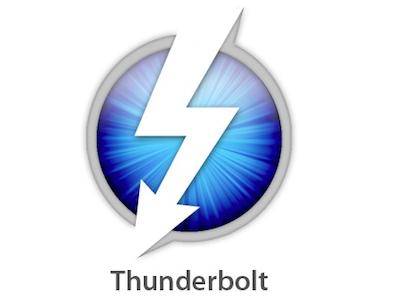Intel Working on Thunderbolt for Tablets, Phones
Dadi Perlmutter, executive vice president and general manager of the Intel Architecture Group, told the IDG News Service during an interview at Computex that the company is working on a low-power version of Thunderbolt for tablets and smartphones. Whether it actually arrives on mobile devices will depend on how well WiGig is adopted by consumers.
"Do users want Thunderbolt or do they want WiGig? They might want both. We are working on both," Perlmutter said.
Intel is actually backing WiGig, a specification led by the Wireless Gigabit Alliance that's focused on transmitting data across short distances (such as a room). It can transfer data wirelessly at a rate up to 7 Gbps, faster than a standard wireless connection, using the 60 GHz spectrum. Devices supporting WiGig are slated to arrive next year, and the Wi-Fi Alliance is expected to eventually take the reins of WiGig development.
Currently smartphones and tablets only sport micro USB ports that connect to peripherals. USB 3.0 is just now starting to roll out, with the Asus Transformer Pad Infinity revealed at Computex being one of the first in the mobile arena to provide a full SuperSpeed port.
The adoption of Thunderbolt in desktops and laptops has been reportedly sluggish due to the popularity of the slower USB 3.0. Thunderbolt cables and peripherals haven't helped the adoption rate, as they're more expensive compared to USB 3.0 devices and cables. However Intel has reportedly doubled the speed of the Thunderbolt connect to 20 Gbps thanks to the release of optical cables.
In Thunderbolt's defense, the tech didn't actually begin to surface on non-Apple desktops until May 2012. It's a joint venture between Intel and Apple, and made its first appearance on the MacBook Pro in 2011. It uses the same connector as Mini DisplayPort, and combines PCI Express (PCIe) and DisplayPort (DP) into one serial signal alongside a DC connection for electric power which is transmitted over a single cable.
Thunderbolt is capable of up to 10 Gbps per channel in both directions, and up to seven compatible peripherals can be daisy chained through one Thunderbolt connector. Intel claims users can transfer a full-length HD movie in less than 30 seconds, and backup 1 year of continuous MP3 playback in just over 10 minutes.
Get Tom's Hardware's best news and in-depth reviews, straight to your inbox.
"We'll see what's winning," Perlmutter said.

Kevin Parrish has over a decade of experience as a writer, editor, and product tester. His work focused on computer hardware, networking equipment, smartphones, tablets, gaming consoles, and other internet-connected devices. His work has appeared in Tom's Hardware, Tom's Guide, Maximum PC, Digital Trends, Android Authority, How-To Geek, Lifewire, and others.
-
WithoutWeakness The reason people aren't all going out and buying Thunderbolt everything is simply due to 3 factors:Reply
1) Manufacturers aren't putting it on all their devices
2) There are so few peripherals that use it
3) The products that do implement it cost a hefty premium compared to those that use USB 3.0
Thunderbolt is amazing for high-speed external storage (SSD's and RAID arrays) but that is about it. USB 3.0 is fast enough for most users' needs and is reasonably priced, as well as being compatible with all of their USB 2.0 peripherals. The fact that Thunderbolt carries a DisplayPort signal is negated by the fact that very few displays offer DisplayPort inputs and those that do are far more expensive. Apple is the only company with a Thunderbolt display that offers additional functionality (3, USB 2.0, 1x Firewire 800, 1x GbE, webcam, speakers) and it costs $1000. Nobody else is even using this connector because it costs so much and isn't on any devices.
Intel needs to drop the price of using Thunderbolt and make it accessible to more manufacturers if they want it to catch on. It's implementation of external PCIe has many possibilities but they're standing in their own way if they think people will just needlessly buy it if it has an Intel logo on it. -
whiteodian Agree with WithoutWeakness. I also want to say I am more interested in Thunderbolt than WiGig because wireless N is pretty fast and I am hoping that we will be able to get an ultrabook laptop and connect via Thunderbolt to a separate box with discrete desktop graphics cards in there. Best of both worlds :DReply -
lazykoala The highest end motherboards have thunderbolt compatibility and 802.11ac wifi, but that's about all I have seen.Reply -
dimar Sony should put Thunderbolt on their future camroders. Limiting my Sony 1080p60 camcorder to USB 2.0 is beyond shame for Sony.Reply -
InvalidError Reply
My newest LCD (Dell US2212) has DisplayPort and I got it for $160 (it was on-sale for 40% off) but it only has one DP port, so no support for pass-through to daisy-chain displays.10918480 said:The fact that Thunderbolt carries a DisplayPort signal is negated by the fact that very few displays offer DisplayPort inputs and those that do are far more expensive.
It isn't the DisplayPort connectors that make Thunderbolt expensive. It is all the extra bits (hardware + licensing) that are required for pass-through and mixed DP+PCIe support for Thunderbolt that make those devices more expensive.
The notion of needing somewhat expensive active cables for Thunderbolt even for fairly short runs likely irks many people too. -
vagnluv Seems some of you forget that latency is one of the most important advantages TB has over USB3, making it the only viable option for connecting external GPUs and other PCIe peripherals. If you are into stuff like pro music production and video editing, USB3 is not an option with a future. We're on the verge of 4K video and TB is the only solution that'll deliver.Reply -
InvalidError Reply
Latency on USB3 could be substantially reduced by eliminating protocol conversions/encapsulations between PCIe and USB3 but that would require either rewriting the standard or implementing an HCI that bypasses PCIe.10919501 said:Seems some of you forget that latency is one of the most important advantages TB has over USB3
Latency is not a major concern for external GPUs since we are only talking microseconds which the graphics drivers could be optimized to work around of fairly easily - assuming the graphics drivers even needs to read anything back from the GPU, which would make the rendering process largely latency-agnostic.
The biggest problem there would be bandwidth since USB3 has roughly half as much usable bandwidth as PCIe 3.0 x1 but you need x4 to get the most out of mid/high-end GPUs in graphics-intensive games/applications.
Reducing the underlying protocols' latency does you no good if the bandwidth to support whatever it is you are trying to do is not there in the first place. USB3 has less than 1/10th the bandwidth necessary to support high-end GPUs; nowhere near good enough to start worrying about latency. -
somebodyspecial Hope Intel loses here...I love the 4k push, but would rather have it without the fees to Intel. Go wigig. Another rev or 2 should enable much faster than 7Gbps killing the need for Intel to be involved soaking us for more money.Reply -
Someone Somewhere Yeah, other thing is that USB3.0 is backwards compatible, which helps upgrade rate. Plus phones with TB will still need a microUSB connector to charge, so who will want to buy a $40 (or whatever it is now; fibre will likely increase it) cable that you have to reach around the back of your computer to plug in, and breaks if kinked too tightly.Reply
Other thing is that daisy-chaining significantly reduces the usability of the interface - having to disconnect and reconnect your screen to plug in an external HDD for example, or having a second wire coming out of your mouse to plug in something else.
Picking which devices support the new 20Gbit link will also be difficult, and you'll have to do serious chain optimizing to actually get it to work as well as possible.
I expect to see thunderbolt have a similar legacy to IEEE1394 - I'll use it about two, maybe three times, then I'll get a new computer that doesn't have it until Apple's next lemon reaches main-stream existence. -
ojas I think it'll be great for a phone/tablet. One port to charge, connect to a display, access storage, daisy chain all three to a gamepad and a external PCIe card...Reply
